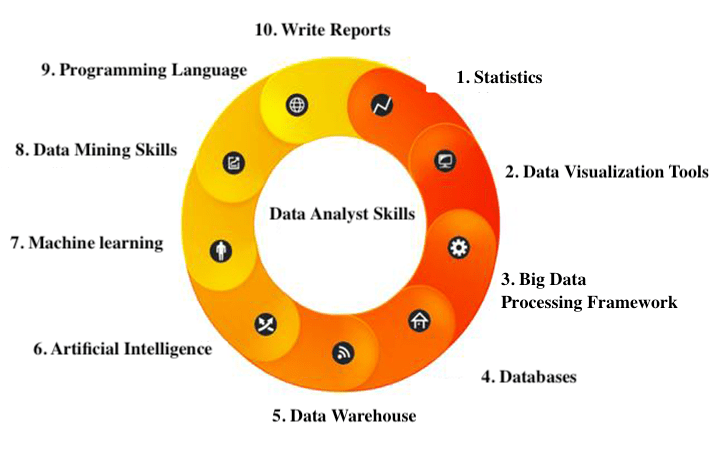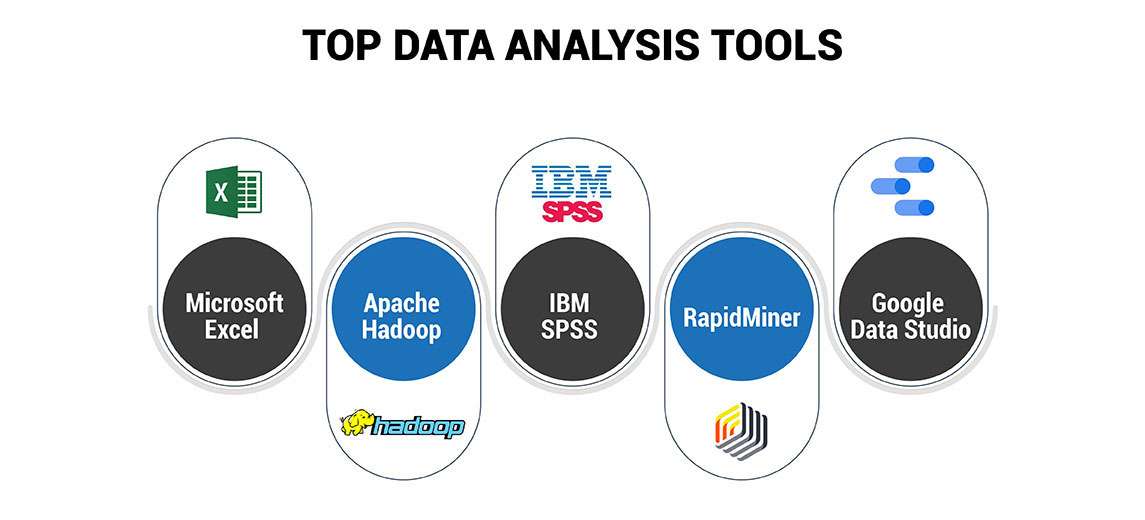
- What is a Data Analyst?
- What Is Data Analysis and Why Does it Matter?
- Roles and Responsibilities of Data Analysts
- Key Skills for Data Analysts
- Data Analytics Career Outlook
- Why Is Data Analytics the Hottest Career?
- Tools for Data Analysis
- Types of Data Analysts
- Conclusion
What is a Data Analyst?
A data analyst gathers, processes, interprets, and examines large and complex datasets using specific strategies, statistical methods, and specialized software tools. They aim to uncover hidden trends, correlations, patterns, and valuable insights that can guide strategic decision-making. By analyzing both structured and unstructured data, they help organizations identify opportunities, solve problems, and forecast future outcomes with precision. Their insights help businesses stay competitive, optimize operations, and increase profitability. Data analysts work closely with sectors such as finance, marketing, healthcare, technology, retail, education, and more, improving operational efficiency, enhancing customer satisfaction, and driving performance across various departments. They play a key role in reducing costs, improving service delivery, and streamlining business processes. Furthermore, through expertise gained from Data Science Training, they ensure that organizations are able to make informed, data-driven decisions that lead to measurable success. Their role is also vital in data quality management, ensuring the accuracy, consistency, and completeness of data before it is analyzed and reported. Data analysts use various advanced analytics techniques, such as predictive modeling, data mining, and machine learning algorithms, to extract deeper insights and provide forward-looking recommendations. In this data-driven age, the data analyst’s ability to interpret and communicate insights is crucial for helping organizations adapt to market trends, mitigate risks, and achieve both short- and long-term business goals.
Eager to Acquire Your Data Science Certification? View The Data Science Course Offered By ACTE Right Now!
What Is Data Analysis and Why Does it Matter?
Data evaluation is the procedure of refining, transforming, and shaping information to derive insights and help in decision-making.
Data Analysis Process
- Reviewing and Refining: Data evaluation includes analyzing information to identify loopholes, errors, or lacking values and solving them to make certain information precise and reliable.
- Identifying Patterns and Trends: Using strategies that include gadget learning and information evaluation, we can discover hidden patterns, trends, relationships, and insights inside datasets.
- Decision-Making Support: Data evaluation lets groups make knowledgeable decisions, simplify operations, and manual destiny enterprise strategies.
Roles and Responsibilities of Data Analysts
The significance of information evaluation and control is likewise growing with the growth of information. This can also create troubles for agencies; consequently, Data Analytics play a massive role. They extract actionable insights from complicated datasets by reading developments, detecting patterns, and revealing connections. Information analysts allow corporations to make selections and achieve their dreams more efficiently. Their abilities permit agencies to streamline operations and enhance performance.
- Data collection: Data Collection is all about acquiring facts from exceptional assets to check their completeness and accuracy.
- Data Cleaning: Data Cleaning entails refining information to eliminate any discrepancies that may have occurred during the gathering or recording phase.
- Data Evaluating: Trained on information through strategies and equipment to become aware of their developments.
- Data Visualization: They create significant visualizations to get insights.
- Creating Reports: Make reviews that summarize the final results of the evaluation.
- Offering Guidance: They make recommendations primarily based totally on their findings using information evaluation, assisting individuals who make selections.
Key Skills for Data Analysts
Database Tools
While Excel may be used in many industries, SQL is necessary for dealing with and reading complicated datasets. Consequently, analysts must recognise a way to perform those database operations because they are rather flexible regarding dataset size.
Programming Languages
Suppose you must address datasets and carry out complicated analyses and talent in programming languages, along with Python or R, coulis more. Of Nuseeless, necessities may also fluctuate depending on the activity. Observe activity postings to recognize which language is of high quality to fit your subject of specialization, such as enrolling in a Data Science Course for Beginners to gain foundational knowledge in programming languages like Python or R. These courses can help you develop essential skills in data manipulation, statistical analysis, and machine learning, all of which are valuable for aspiring data analysts.
Data visualization
Ensuring that insights are communicated effectively through help could be very important for information analysts. Standard equipment used encompasses Tableau, Jupyter Notebook, and Excel to make stunning charts and graphs that assist in passing on findings to investors.
Statistics and Mathematics
Decisions in information analytics require an intensive knowledge of standards in addition to mathematical concepts. This knowledge of data allows for choosing the equipment for figuring out variations in information and making legitimate interpretations.

Data Analytics Career Outlook
Role: Data Analyst
Responsibilities
- Ability to research massive datasets to discover patterns, developments, and correlations.
- Create and hold reviews, dashboards, and visualizations.
- Ability to collaborate with cross-useful groups to apprehend commercial enterprise requirements.
- Four. Stay current on enterprise developments and great records analytics and visualization practices.
- Communicate findings and hints to technical and non-technical audiences via written reviews and presentations.
Skills
- Bachelor’s diploma in Mathematics for Data Science, Statistics, or Computer Science.
- Previous paintings enjoy as a records analyst or a comparable function.
- Python, SQL, or PowerBI competencies for manipulating records subsets and visualizing it.
- Four. Practical enjoy with statistical evaluation programs like MS Excel and Tableau.
- Strong analytical and problem-fixing abilities.
- Excellent conversation competencies and interpersonal competencies.
- Furthermore, any knowledge of using cloud-primarily based totally records systems, such as Azure or AWS, could be an advantage.
- Key deliberate function with visibility inside organizations.
- Plenty of activity possibilities throughout sectors.
- Average revenue above ₹13.four lakhs according to year.
- Four. Exposure to the present-day trends in records, AI/ML technologies.
- Chance to pressure extrude and make an effect via a records-orientated approach.
- Microsoft Excel: Excel is a spreadsheet software program for operating with records. It is widely recognized and has an easy-to-use interface that overlays easy-to-superior obligations to be performed on records.
- SQL: Structured Query Language (SQL) allows customers to manipulate relational databases by imparting a manner of querying, inserting, updating, and deleting rows, which includes defining tables or manipulating different database structures.
- Python: Python is an all-purpose language acknowledged for its ease of mastery and clean syntax. It has rich libraries committed to record evaluation, gadget mastery, web development, and more.
- R Programming Language: R is an open-source programming language and software environment mainly used for statistical computing and graphics. It is favored among statisticians and records scientists because it can read complicated record sets.
- Tableau: Tableau is a graphical illustration application that guides interactive and shareable dashboards, charts, or reviews from extraordinary record reasserts without significant coding competencies.
- Power BI: Power BI and it’s Applications is a Microsoft Business Analytics device that provides interactive visualization functions, self-carrier enterprise intelligence abilities, and records coaching options.
- MATLAB: MATLAB is a programming language and computing environment especially used for numerical computation, record evaluation, rule development, and visualization, particularly in engineering and clinical research.
- SAS: SAS is a software program suite utilized in superior analytics, enterprise intelligence, and records management. It offers numerous statistical evaluation and predictive modeling abilities.
- Apache Spark: Apache Spark is a distributed computing machine designed to run massive records quickly and typically through helping Spark APIs in Java, Scala, Python, or R.
- Google Looker: Google Looker is a modern enterprise intelligence (BI) and records analytics platform that enables agencies to explore, analyze, and share records insights. It offers effective records exploration and visualization equipment specializing in records-pushed decision-making at scale. Looker is regularly utilized by records analysts, engineers, and enterprise customers for deep records evaluation and reporting.
- Google Data Studio: Google Data Studio is a free enterprise intelligence and records visualization device developed by Google. It permits customers to create interactive and shareable reviews and dashboards. With Google Data Studio, you may combine records from numerous sources, including Google Website Analytics, Google Ads, Google Sheets, and third-party offerings via connectors.
- Research Analysts : Research Analysts collect, analyze, and interpret records to aid decision-making in numerous industries. They regularly specialize in educational or clinical research, marketplace trends, and enterprise patterns.
- Business Analysts: Business Analysts determine enterprise processes, discover issues, and offer records-pushed guidelines to enhance efficiency, profitability, and ordinary enterprise performance.
- Medical and Healthcare Analysts: These analysts use records to enhance affected person care, streamline operations, and optimize healthcare rules by reading fitness records, trends, and consequences associated with the medical and healthcare fields.
- Business Intelligence Analysts: A Business Intelligence Analyst specializes in gathering, reading, and supplying records to inform strategic enterprise decisions, utilizing equipment like dashboards and data visualization to track key metrics.
- Market Research Analysts: They observe marketplace situations and purchaser conduct by reading information, trends, and competition to assist companies in developing more powerful advertising techniques.
- Operations Research Analysts: They observe mathematical and analytical techniques to solve complicated operational problems and optimize resources, logistics, and structures inside companies.
Why Is Data Analytics the Hottest Career
Data Analytics is the most up-to-date profession because companies and generation fields use records extensively, and there may be an outstanding need for certified folks who can method these records into precious commercial enterprise intelligence. Here are a few extensive motives why Data science Training and records analytics have seemed to be one of the most required and unexpectedly developing careers globally:
Amazon, Microsoft, and Accenture are among multinational organizations, disruptive start-ups, and unicorns that prioritize hiring professionals in Data Analytics, mostly due to the massive advantages that would be derived from optimally using records.
Excited to Obtaining Your Data Science Certificate? View The Data Science Training Offered By ACTE Right Now!
Tools for Data Analysis
Data analysts frequently use diverse equipment to make their work more accurate and green during records evaluation. Here are a few sets of equipment utilized in Data Analysis.
Basic Tools
Advanced Tools
AutoSum occasionally produces errors, which can be fixed easily:
Interested in Pursuing Data Science Master’s Program? Enroll For Data Science Master Course Today!
Emerging Tools

Types of Data Analysts
Data analysts are essential in regulation enforcement, fashion, culinary arts, technology, enterprise, environmental studies, and public administration. They also are recognized through activity titles, like:
Preparing for a Data Science Job Interview? Check Out Our Blog on Data Science Interview Questions & Answer
Conclusion
An information analyst is critical in remodeling uncooked information into significant insights that force knowledgeable decision-making throughout numerous industries. By using statistical techniques, information visualization, and enterprise intelligence tools, information analysts assist companies in becoming aware of trends, optimizing processes, and enhancing universal efficiency. Their work is vital in finance, healthcare, advertising, and e-commerce, where information-driven techniques supported by strong Data Science Training lead to better customer experiences and significant operational improvements. Despite demanding situations like information fine problems and evolving analytical tools, the call for professional information analysts continues. As companies increasingly depend on information for strategic decisions, the position of information analysts will stay vital, evolving with improvements in AI, device learning, and large information technologies.


